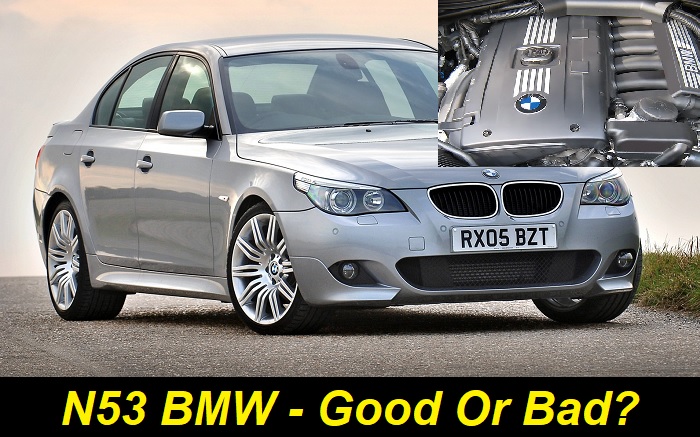We've already got used to the fact that most 6-cylinder engines are V-shaped. This means that the cylinders are located not in one line like in most 4-cylinder engines, but in two lines with two different heads. But the BMW N53 engine is different. It's a straight 6-cylinder engine with one head.
The engine was produced from 2006 to 2013 in Germany. It was originally made for the 5-Series model. If you live in the US, Australia, or Malaysia, you may have never heard about this unit. For these markets, BMW offered the N52 engine which was slightly worse in terms of technology but it could easily work with the high sulfur content of the gasoline. N53 was mainly sold in Europe.

Key facts and my opinion about the engine
- Production years: 2006-2013
- Average lifespan of N53: 180,000-200,000 miles
- Fuel supply type: direct injection
- Power range: 190-272 hp
- Fuel efficiency: average
- Engine block material: aluminum
- Engine reliability score: medium
- The most common problems: ignition coils and spark plugs aren't long-lasting, VANOS issues, injector problems, carbon buildup on intake valves
Main info on the BMW N53 engine
This wonderful engine was the light straight-six unit made by BMW. By the way, the history of this configuration dates back to 1968. But after 2010, BMW wasn't very keen on naturally aspirated engines with big displacement. They started turning to 4-cylinder turbocharged units and only used big-displacement engines in their special sports models.
The N53 was an average engine in terms of customer reviews. It wasn't really brilliant if you look at its longevity and reliability, but the company declared that it was aiming not at longevity but at performance. And you can see that the engine has a wonderful performance in comparison with all other units of this kind.
Here are some facts about the technical specifications of the BMW N53:
- these engines had some types with different displacements - 2.5 or 3 liters;
- the 2.5-liter version has 188 horsepower while the 3-liter versions offer 201-268 horsepower;
- the torque range is 173 lb-ft to 236 lb-ft which is not bad given the engine doesn't have a turbocharger;
- the engine was mainly used on the E60 model, but these units were also installed in E63, E90, F10, and some other models of BMW vehicles;
- the construction is quite simple, but it's still not so easy to repair this engine;
- the magnesium alloy block seemed to be a brilliant idea, but now experts are skeptical about this decision;
- also, the double-VANOS system is very hard to repair or even assemble, so it's expensive to maintain.
The engine was not bad, but we can't say it was the best technological engine made by BMW. We see that the company didn't include many important technologies that were there in 2006 when the engine was introduced. This led to some problems with the unit and to experts saying that the engine was archaic.
But we know that BMW owners all over Europe love the N53. In America, the engine was only presented as a turbocharged version (N54) but it was extremely problematic and isn't thought to be a good choice if you buy a used BMW.
How many miles can the N53 engine go?
We wouldn't say this is the most reliable engine in the world (we don't think that BMW is all about reliability). It's created for fun driving, but it can only last about 180 000 to 200 000 miles. This is not a lot for a 6-cylinder engine with quite a big displacement. But we now see that these units keep failing at high mileage and it's not rational to repair them.
The N53 will probably start malfunctioning hard at 130 000 miles. This is the point when many owners decide to start selling their BMWs because these vehicles start asking for a lot of money.
But we know cases when the N53 engine failed much earlier. We've spoken to experts in the UK and they agreed that the BMW N53 can fail at 60 000 miles already. The reason is that these engines have quite a lot of different problems. And the owners have to keep an eye on them all the time. Once you overlook some problem, it will kill the engine very fast.
So, if you own a BMW with the N53 engine, keep servicing it regularly and forget about driving a car that shows a Check Engine light or some other problems.
What problems are popular with the N53 by BMW?
Unfortunately, we know about a lot of problems that can happen with your N53 engine. Some of them are also common for the N54, but the latter was one of the worst straight-six engines in the world. So, we decided to make up the list of problems that will be useful for you in two cases: when you own a vehicle with such an engine and when you want to buy a used car with this engine.
Here's what we found out about the common problems of the N53 engine:
- The traditional BMW problems with ignition coils and spark plugs are all there. But bear in mind that you will have to spend a lot on the set of six coils and six plugs.
- The VANOS system didn't get any better. This is the valve control system that is aimed at improving the engine power and reducing fuel consumption, but it needs to be repaired very often, especially at high mileage.
- Injectors are weak. They will need to be cleaned or even replaced quite often. Unfortunately, the cost of this repair will be amazingly high.
- Also, these engines have HPFP (high-pressure fuel pump). These pumps are so unreliable that you can never predict when you are going to have problems.
- Oil leaks - always check the engine for oil leaks, otherwise, you may get problems because of low oil level and also because of oil getting to some wiring and connectors.
- Starter. BMW starters are reliable, but when they fail, you will need to spend a fortune to buy a new one.
We would say that the most common problems for a high-mileage N53 are the VANOS problems and also the HPFP problems. These are the most expensive things that can break in this engine and they break as soon as they can.
You still can drive your car for a while after the engine falls to a limp mode if the VANOS system malfunctions, but you will not be able to drive your BMW if the HPFP is broken. So if you see a BMW 5 Series with a sad owner trying to get some help on the road, stop and give him or her the lift to the next car service station or BMW dealer.
Is there anything good about this engine?
We know that many owners are glad about the gas mileage. If you own a 5 Series with the N53, you will get around 18-20 MPG in the city and up to 32 MPG on the highway. This is really cool given you have the big 6-cylinder engine with a lot of power under the hood. But it's true for a manual transmission. Automatic transmission will make the gas mileage a little worse.
Actually, this engine may be described as reliable. It has a very strong block of cylinders, a wonderful head, good cooling system. It has no traditional problems of the BMW engines of that epoch but the VANOS and the fuel injection system. So, it's not bad at all.
Also, we can think of some other advantages:
- really fun to drive - these engines are powerful and allow active driving;
- we've seen engines with over 200 000 miles, so the things are not so bad;
- the overall expenses are not bad at all given the engine offers good gas mileage;
- you always have some extra power under your right leg which is important;
- basically, no minor problems are possible, all other parts of the engine are reliable.
If you maintain and service this engine just like it should be maintained, it will deliver only good emotions. For example, after 60 000 - 70 000 miles you should check the double-VANOS system and maybe service the VANOS valves. Also, at 100 000 miles, you should check the catalytic converter and all the ecological parts of the engine, the fuel injection system, and the HPFP.
If you maintain the engine, it will last longer and will not give you problems. And yes, this engine will be a very bad choice if you don't like doing regular service and taking care of your car.
Final words
We don't recommend buying used high-mileage BMW vehicles powered by the N53 engine. In order to be sure that this engine will not cause problems, you need to know how it has been used and serviced. But if you have owned this car for years and you know that everything works fine in this engine, you can be sure that it's a very long-lasting unit that will only bring you happy hours on the road.
About the authors
The CarAraC research team is composed of seasoned auto mechanics and automotive industry professionals, including individuals with advanced degrees and certifications in their field. Our team members boast prestigious credentials, reflecting their extensive knowledge and skills. These qualifications include: IMI: Institute of the Motor Industry, ASE-Certified Master Automobile Technicians; Coventry University, Graduate of MA in Automotive Journalism; Politecnico di Torino, Italy, MS Automotive Engineering; Ss. Cyril and Methodius University in Skopje, Mechanical University in Skopje; TOC Automotive College; DHA Suffa University, Department of Mechanical Engineering






Add comment